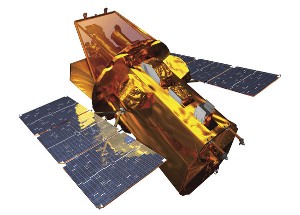May 30 2014
NASA's top ranking among its astronomy satellites, not including the Hubble Space Telescope and Chandra X-ray Observatory, has been awarded to the Swift observatory, a project that involves Penn State scientists.
Swift carries two telescopes whose lead scientists are Penn State astronomers and a third telescope led by a NASA scientist. Science and flight operations for Swift are controlled by Penn State from the Mission Operations Center at the University Park campus.

NASA reviews the scientific performance of its astronomical satellites every two years in order to decide if they should continue operating and what their funding level should be. NASA recently released its May 2014 Senior Review report, which gives Swift the top ranking among nine of NASA's astronomy satellites. The Hubble Space Telescope and Chandra X-ray Observatory were reviewed separately and were not included in this ranking.
The Swift satellite discovers and measures gamma-ray bursts, the most powerful explosions in the universe, and their afterglow in X-ray, optical, and ultraviolet wavelengths of light. Scientists use these detections to explore the universe back to less than five percent of its current age, to study the expansion of the universe, to find the origin of particular types of gamma-ray bursts, and to make unique searches for rare types of cosmic explosions.
"The entire Swift team is delighted that NASA has recognized the high priority of our scientific mission and has extended it for at least another two years," said Penn State Professor of Astronomy and Astrophysics David Burrows, who is the lead scientist for Swift's X-ray Telescope. Swift also carries an ultraviolet/optical telescope, for which Penn State Research Associate Michael Siegel is the lead scientist, and a burst alert telescope, for which Scott Barthelmy at NASA's Goddard Space Flight Center in Greenbelt, Maryland, is the lead scientist. John Nousek, professor of astronomy and astrophysics, is the director of the Penn State Mission Operations Center for Swift.
Swift Sees Changes in the Milky Way 2006 - 2013
The principal investigator of the Swift mission is Goddard's Neil Gehrels, who also is an adjunct professor of astronomy and astrophysics at Penn State. "Swift's built-in, near-immediate response capability allows us to make early, frequent, and continuing observations of new gamma-ray bursts, supernova explosions, and other powerful explosions in the universe," Gehrels explained.
Swift's Ultraviolet/Optical Telescope resulted from Penn State's collaboration with the Mullard Space Science Laboratory of the University College-London, and its X-ray Telescope was developed from Penn State's collaboration with the University of Leicester, the Brera Observatory in Merate, Italy, and the Science Data Center of the Italian space agency. These instruments have been providing vital measurements of the afterglows of the gamma-ray bursts since Swift was launched in November 2004.
NASA's May 2014 Senior Review commended Swift's broad and responsive scientific program, which includes collaborations with many of the world's other leading observatories. "Swift continues to provide unique and exciting science both as stand-alone results and as part of multi-wavelength campaigns," the review notes. Referring to Swift's contributions to the understanding of how objects in the universe change over time, the NASA report states that "Swift is the premier facility for multi-wavelength time-domain astronomy in the world." As a result of NASA'S 2014 Senior Review, Swift will continue to collect new observations of the universe for at least the next two years.